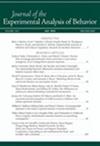Generalized contextual control based on nonarbitrary and arbitrary transfer of stimulus functions
Abstract
Two experiments with human adults investigated the extent to which the transfer of function in accordance with nonarbitrary versus arbitrary stimulus relations may be brought under contextual control. Experiment 1 comprised four phases. Phase 1 consisted of multiple-exemplar training to establish discriminative functions for solid, dashed, or dotted lines. Phase 2 trained and tested two equivalence classes, each containing a 3D picture, a solid, a dashed, and a dotted form. During Phase 3, a discriminative function was established for each 3D picture. Phase 4 presented the solid, dashed, and dotted stimuli in two different frames, black or gray. The black frame cued function transfer based on nonarbitrary stimulus relations (Frame Physical); the gray frame cued function transfer based on equivalence relations (Frame Arbitrary). Testing and training with the frames was continued until contextual control was established; subsequently contextual control was demonstrated with novel equivalence classes with stimuli composed of the same forms. Experiment 2 replicated and extended Experiment 1 by demonstrating that such contextual control generalized to novel equivalence classes comprising novel forms and responses. The potential implications of the findings for developing increasingly precise experimental analyses of clinically relevant phenomena are considered (e.g., defusion).

 求助内容:
求助内容: 应助结果提醒方式:
应助结果提醒方式:


